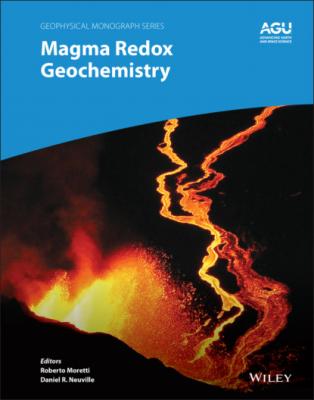Magma Redox Geochemistry. Группа авторов
Читать онлайн.| Название | Magma Redox Geochemistry |
|---|---|
| Автор произведения | Группа авторов |
| Жанр | Физика |
| Серия | |
| Издательство | Физика |
| Год выпуска | 0 |
| isbn | 9781119473244 |
85 Stagno V., Frost, D. J., McCammon, C. A., Mohseni, H., & Fei, Y. (2015). The oxygen fugacity at which graphite or diamond forms from carbonate‐bearing melts in eclogitic rocks. Contributions to Mineralogy and Petrology, 169, 16. https://doi.org/10.1007/s00410‐015‐1111‐1
86 Stagno, V., Cerantola, V., Aulbach, S., Lobanov, S., McCammon, C., & Merlini, M. (2019). Carbon‐bearing phases throughout Earth’s interior: Evolution through space and time. In: Orcutt, B., Daniel, I., & Dasgupta, R. (Eds.), Deep Carbon: Past to Present. Cambridge: Cambridge University Press. pp. 66–88.
87 Tappe, S., Smart, K. A, Torsvik, T. H., Massuyeau, M., & de Wit, M. C. J. (2018) Geodynamics of kimberlites on a cooling Earth: Clues to plate tectonic evolution and deep volatile cycles. Earth and Planetary Science Letters, 484, 1–14. doi:10.1016/j.epsl.2017.12.013
88 Taylor, W. R., & Green, D. H. (1988). Measurement of reduced peridotite‐C‐O‐H solidus and implications for redox melting of the mantle. Nature, 332, 349–352. https://doi.org/10.1038/332349a0
89 Thomson, A. R., Walter, M. J., Kohn, S. C., & Brooker, R. A. (2016). Slab melting as a barrier to deep carbon subduction. Nature, 529, 76–79. https://doi.org/10.1038/nature16174
90 Trail, D., Watson, E. B., & Tailby, N. D. (2011). The oxidation state of Hadean magmas and implications for early Earth’s atmosphere. Nature, 480, 79–82. https://doi.org/10.1038/nature10655
91 Tschauner, O., Huang, S., Greenberg, E., Prakapenka, V. B., Ma, C., Rossman, G. R., et al. (2018). Ice‐VII inclusions in diamonds: Evidence for aqueous fluid in Earth’s deep mantle. Science, 356, 1136–1139. 10.1126/science.aao3030
92 Wade, J., & Wood, B. J. (2005). Core formation and the oxidation state of the Earth. Earth and Planetary Science Letters, 236, 78–95. https://doi.org/10.1016/j.epsl.2005.05.017
93 Walter, M., Bulanova, G., Armstrong, L., Keshav, S., Blundy, J. D., Gudfinnsson, G., et al. (2008). Primary carbonatite melt from deeply subducted oceanic crust. Nature, 454, 622–625. https://doi.org/10.1038/nature07132
94 Wang, Z., & Becker, H. A. (2013). Ratios of S, Se and Te in the silicate Earth require a volatile‐rich late veneer. Nature, 499, 328–331. https://doi.org/10.1038/nature12285
95 Wark, D. J., & Lovering, F. (1977). Marker events in the early evolution of the solar system: evidence from rims on Ca‐Al‐rich inclusion in carbonaceous chondrites. Proceedings of the Lunar Planetary Science Conference, 8th, 95–112.
96 Williams, S. N, Schaefer, S. J., Marta Lucia Calvache, V., & Lopez, D. (1992). Global carbon dioxide emission to the atmosphere by volcanoes. Geochimica et Cosmochimica Acta, 56(4), 1765–1770. doi:https://doi.org/10.1016/0016‐7037(92)90243‐C.
97 Wirth, R., Dobrzhineskaya, L., Harte, B., Schreiber, A., & Green, H. W. (2014). High‐Fe (Mg, Fe)O inclusion in diamond apparently from the lowermost mantle. Earth and Planetary Science Letters, 404, 365–375. https://doi.org/10.1016/j.epsl.2014.08.010
98 Wood, B. J., Walter, M. J., & Wade, J. H. (2006). Accretion of the Earth and segregation of its core. Nature, 441, 825–833. https://doi.org/10.1038/nature04763
99 Wyllie, P. J., & Huang, W. L. (1975). Influence of mantle CO2 in the generation of carbonatites and kimberlites. Nature, 257, 297–299. https://doi.org/10.1038/257297a0
100 Yang, X., Gaillard, F., & Scaillet, B. (2014). A relatively reduced Hadean continental crust and implications for the early atmosphere and crustal rheology. Earth and Planetary Science Letters, 393, 210–219. https://doi.org/10.1016/j.epsl.2014.02.056
3 Oxygen Fugacity Across Tectonic Settings
Elizabeth Cottrell1, Suzanne K. Birner2, Maryjo Brounce3, Fred A. Davis4, Laura E. Waters5, and Katherine A. Kelley6
1 Department of Mineral Sciences, National Museum of Natural History, Smithsonian Institution, Washington, DC, USA
2 Division of Natural Sciences, Nursing, and Mathematics, Berea College, Berea, KY, USA
3 Department of Earth and Planetary Sciences, University of California Riverside, Riverside, CA, USA
4 Department of Earth and Environmental Sciences, University of Minnesota Duluth, Duluth, MN, USA
5 Department of Earth and Environmental Science, NewMexico Institute of Mining and Technology, Socorro, NM, USA
6 Graduate School of Oceanography, University of Rhode Island, Narragansett, RI, USA
ABSTRACT
Experiment and observation have established the centrality of oxygen fugacity (fO2) to determining the course of igneous differentiation, and so the development and application of oxybarometers have proliferated for more than half a century. The compositions of mineral, melt, and vapor phases determine the fO2 that rocks record, and the activity models that underpin calculation of fO2 from phase compositions have evolved over time. Likewise, analytical method development has made new sample categories available to oxybarometric interrogation. Here we compile published analytical data from lithologies that constrain fO2 (n=860 volcanic rocks – lavas and tephras – and n=326 mantle lithologies – the majority peridotites) from ridges, back‐arc basins, forearcs, arcs, and plumes. Because calculated fO2 varies with choice of activity model, we recalculate fO2 for each dataset from compositional data, applying the same set of activity models and methodologies for each data type. Additionally, we compile trace element concentrations (e.g., vanadium) which serve as an additional fO2‐proxy. The compiled data show that, on average, volcanic rocks and mantle rocks from the same tectonic setting yield similar fO2s, but mantle lithologies span a much larger range in fO2 than volcanics. Multiple Fe‐based oxybarometric methods and vanadium partitioning vary with statistical significance as a function of tectonic setting, with fO2 ridges < back arcs < arcs. Plume lithologies are more nuanced to interpret, but indicate fO2s ≥ ridges. We discuss the processes that may shift fO2 after melts and mantle lithologies physically separate from one another. We show that the effects of crystal fractionation and degassing on the fO2 of volcanics are smaller than the differences in fO2 between tectonic settings and that effects of subsolidus metamorphism on the fO2 values recorded by mantle lithologies remain poorly understood. Finally, we lay out challenges and opportunities for future inquiry.
3.1. INTRODUCTION
The role that oxygen fugacity (fO2) plays in producing the unique topography of Earth’s surface, defined by high‐standing continents and low‐lying ocean basins, was recognized in the
